
7 engineering disruptors
Transforming life, business and the global economy

Transforming life, business and the global economy
By Brian Caldwell Faculty of EngineeringFrom the design of the Waterloo Pump, which brought clean water to communities in developing countries, to the invention of the BlackBerry, which opened the floodgates for the ubiquitous smartphone, Waterloo Engineering students, graduates and researchers have made an indelible mark on the world.
And in a technological age that includes artificial intelligence, ever-faster wireless communications and soon-to-be-self-driving vehicles, that process of innovation and contribution is only accelerating.
To wit, here is a sampling of seven people with proud ties to Waterloo Engineering discussing how they have made, are making, or hope to make disruptive differences in endeavours ranging from building websites to excavating landmines.
It is by no means an exhaustive list — or the end of the story. Stay tuned into the future as many more do their part to improve lives the world over.
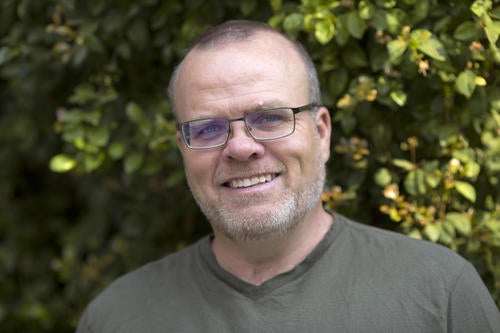 Rasmus Lerdorf created the PHP scripting language to put dynamic content on websites soon after earning a degree in systems design engineering at Waterloo in 1993. Initially meant only to make his consulting job easier, PHP took on a life of its own when he released it as an open source toolkit. Today, the simple, elegant software language powers or partially powers an estimated 60 to 80 per cent of the interactive websites on the Internet, allowing users to do everything from renting cars to catching up with friends on Facebook.
Rasmus Lerdorf created the PHP scripting language to put dynamic content on websites soon after earning a degree in systems design engineering at Waterloo in 1993. Initially meant only to make his consulting job easier, PHP took on a life of its own when he released it as an open source toolkit. Today, the simple, elegant software language powers or partially powers an estimated 60 to 80 per cent of the interactive websites on the Internet, allowing users to do everything from renting cars to catching up with friends on Facebook.
Q. Why has PHP been so successful?
A. It was badly needed because the web was just exploding at that time, but it wasn’t all about me. I just happened to be the first person at the party. When open source hit and people started sending me fixes for it, the ongoing development of PHP became a worldwide effort. Hundreds and hundreds of developers gathered around this thing that I had started. Where we are today is way more about that group effort than it is about me.
Q. How is PHP contributing to the world?
A. I hope it has helped people put their dreams and ideas, their creativity and uniqueness, online. There is a lot of criticism of its technical aspects out there, but all that disappears when I see what people have done with it. After a tsunami hit Sri Lanka, for instance, I met with a group of young people there in 2005. PHP enabled them to create an incredible disaster management system that has since been used in about 75 major natural disasters around the world. That is just amazing to me. It has literally saved lives.
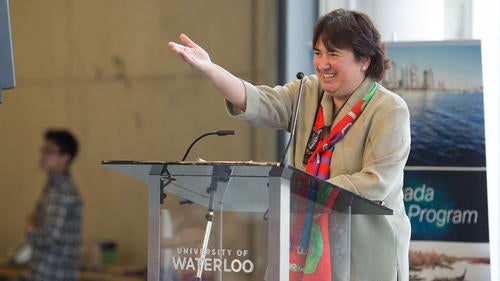 Catherine Rosenberg, an electrical and computer engineering professor, Canada Research Chair in the Future Internet and Cisco Research Chair in 5G Systems, leads a new research partnership with Cisco Systems Canada on the future of wireless networks. She has established two research teams to tackle challenges in 5G enterprise networks — one in networking and communications, and the other in security, dependability and software.
Catherine Rosenberg, an electrical and computer engineering professor, Canada Research Chair in the Future Internet and Cisco Research Chair in 5G Systems, leads a new research partnership with Cisco Systems Canada on the future of wireless networks. She has established two research teams to tackle challenges in 5G enterprise networks — one in networking and communications, and the other in security, dependability and software.
Q. What is at the heart of the coming 5G networks?
A. The next generation of wireless systems, 5G, is not a single technology but a collection of advanced technologies that need to be integrated. What they will enable falls into three main categories:
4G on steroids, or much, much faster data transmission; reliable, low-latency service for critical applications, including remote surgery and autonomous vehicles; and the Internet of Things, which has the potential to connect billions of things, large and small, together.
Q. How will these advances change the world?
A. To understand how 5G wireless networks will affect our lives, it is useful to consider the impact existing 4G technology has already had. Look at how much time we spend on our smartphones, doing everything from sending messages to our children to working on the go. Well, 5G is the next generation, the next step, and with much faster, much more consistent wireless service enabling us to do much more via the Internet, we will be even more glued to our phones and other devices.
Q. What is your main area of interest within the huge 5G field?
A. Instead of focusing on one or two technologies, I am concerned with how all of these new technologies will be integrated into the most efficient and secure systems.
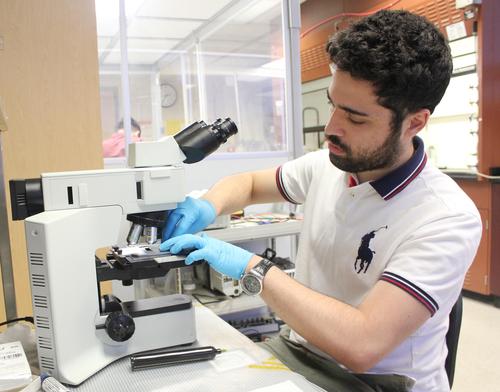 Khaled Ibrahim, a doctoral candidate in mechanical engineering at Waterloo, is developing novel materials — including graphene oxide gel and functionalized two- dimensional materials — to boost the efficiency of perovskite solar cells and gas sensors, among other applications. Fabricated in just eight minutes using a specific form of laser treatment to alter existing materials, the new materials are also less expensive and easier to work with than the originals.
Khaled Ibrahim, a doctoral candidate in mechanical engineering at Waterloo, is developing novel materials — including graphene oxide gel and functionalized two- dimensional materials — to boost the efficiency of perovskite solar cells and gas sensors, among other applications. Fabricated in just eight minutes using a specific form of laser treatment to alter existing materials, the new materials are also less expensive and easier to work with than the originals.
Q. What impact do you hope these new materials will have?
A. It is exciting because they have never been fabricated before, so there is an element of the unknown here. A key goal is improving solar cells to better harness our most important source of renewable energy — the sun. They could also be used in sensors to detect some greenhouse gas emissions that are currently going undetected at factories, for instance. We hope there are multiple applications to help the environment.
Q. What motivates you to do this work?
A. Growing up in Egypt, where there is severe pollution and devastating storms, made me appreciate the urgency of addressing climate change. According to projections, just to limit the temperature increase to 2°C, we will have to reduce our global emissions in the next 30 years by as much as we have increased them in the last 30 years. That is not to be taken lightly. As engineers, as loving parents and grandparents, we have an obligation to leave a habitable world for our children. That is why I am motivated to make a difference — even if only by 0.01 per cent.
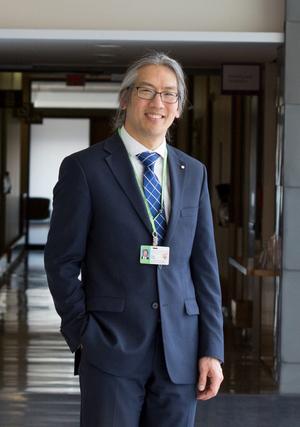 Tom Chau, vice-president of research at the Holland Bloorview Kids Rehabilitation Hospital, has spent almost two decades creating communication tools and other technologies for children with complex disabilities since earning his doctorate in systems design engineering at Waterloo in 1998. Included is the Hummer, an award-winning device that senses vocal cord vibrations and uses them as a switch, enabling non-verbal kids to operate computers and other communication aids via specialized software.
Tom Chau, vice-president of research at the Holland Bloorview Kids Rehabilitation Hospital, has spent almost two decades creating communication tools and other technologies for children with complex disabilities since earning his doctorate in systems design engineering at Waterloo in 1998. Included is the Hummer, an award-winning device that senses vocal cord vibrations and uses them as a switch, enabling non-verbal kids to operate computers and other communication aids via specialized software.
Q. What inspired you to do this work?
A. I had a job at IBM after leaving Waterloo, but when my first son was born I realized I really wanted to do something related to children and have more immediate impact. With everything that had to come together for it to happen, holding a baby in my hands was amazing, nothing short of a miracle. I decided I would try to maximize the potential of all children, so I quit my job and approached Holland Bloorview with some ideas. Fortunately, I landed a post-doctoral fellowship, which gave me three years of salary, and I have never looked back.
Q. What do you think the future holds in your field?
A. It is extremely promising. We’ve given a great deal of attention in the last decade to brain-machine interfacing and I think that is the next frontier, where we’ll be able to bypass the motor system altogether and interact with our environment by mental activity alone. We have already created a system, for example, that makes it possible to type 50 characters a minute using only the mind. Such technology will be another level of game-changing for kids with disabilities, allowing them to lead healthy, meaningful lives.
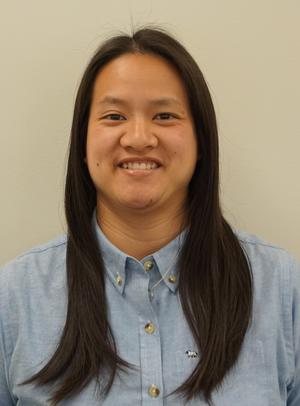 Agnes Lam, who earned undergraduate and master’s degrees in electrical and computer engineering at Waterloo, is working to commercialize a system using motion sensors and machine-learning software to help both patients and physiotherapists after hip and knee replacements. The project at Cardon Rehabilitation & Medical Equipment Ltd. of Burlington, ON., is a direct extension of her graduate research under the supervision of professor Dana Kulić.
Agnes Lam, who earned undergraduate and master’s degrees in electrical and computer engineering at Waterloo, is working to commercialize a system using motion sensors and machine-learning software to help both patients and physiotherapists after hip and knee replacements. The project at Cardon Rehabilitation & Medical Equipment Ltd. of Burlington, ON., is a direct extension of her graduate research under the supervision of professor Dana Kulić.
Q. What are the system’s benefits?
A. On the patient side, our Automated Rehabilitation System provides immediate visual feedback via a virtual avatar on a monitor so they can see how they’re performing exercises compared to the correct motion. That gives patients guidance and motivation to do their prescribed exercises well. For physiotherapists and doctors, the system provides highly accurate data, even when they’re not present, so they can track progress and modify treatment if necessary.
Q. How did you get into this field?
A. I worked in a hospital IT department during a high school co-op term and was then fortunate to do two co-op terms with Professor Kulić as an undergraduate. I needed physiotherapy myself for a basketball injury, and combining technology with medicine has always fascinated me. I see it as a direct way to help people and contribute to society.
Q. What are your expectations for the system?
A. I’m hoping this tool helps to improve diagnosis and treatment for physiotherapy, first for hip and knee replacements and later for a host of other medical applications. If professionals are more informed and patients are more motivated, people should get better sooner.
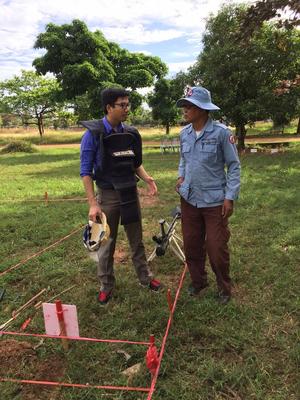 Richard Yim, who graduated from Waterloo with a degree in mechanical engineering in 2016 and completed the Master of Business, Entrepreneurship and Technology program at the Conrad School the following year, is on a mission to rid the world of landmines, a problem he has been acutely aware of since he was taught to be wary of them while growing up in his native Cambodia. A company he co-founded, Demine Robotics, hopes to have a small, lightweight robotic device on the market by the end of this year to safely dig live landmines out of the ground.
Richard Yim, who graduated from Waterloo with a degree in mechanical engineering in 2016 and completed the Master of Business, Entrepreneurship and Technology program at the Conrad School the following year, is on a mission to rid the world of landmines, a problem he has been acutely aware of since he was taught to be wary of them while growing up in his native Cambodia. A company he co-founded, Demine Robotics, hopes to have a small, lightweight robotic device on the market by the end of this year to safely dig live landmines out of the ground.
Q. Why is excavation of landmines the focus at Demine?
A. The more we learned by talking to experts, the more we realized that what the people doing the difficult job of landmine clearance need help with the most is digging them out of the ground. Deminers currently use hand shovels to excavate landmines after locating them with metal detectors, a task that is time-consuming and labour-intensive in addition to being the most dangerous part of the process.
Q. What have you learned during development of your device?
A. When we began work on this problem as a Capstone Design project, we concentrated on a robot that would deactivate landmines by cutting them open and melting the explosives inside. That concept is probably more exciting, but we soon saw it made more sense to pivot to excavating landmines instead. The lesson for young engineers, I think, is to build something practical and needed rather than trying to build something that is just really cool.
 Simarjeet Saini, an electrical and computer engineering professor at Waterloo, is chief scientist at a startup working to commercialize research on inexpensive water sensors. Nanolytix has developed a prototype that monitors water going through filters in treatment systems for potentially deadly E. coli bacteria and other pathogens. After partnering with a U.S. filter company, the initial goal is to introduce the sensors commercially in Asia and Southeast Asia.
Simarjeet Saini, an electrical and computer engineering professor at Waterloo, is chief scientist at a startup working to commercialize research on inexpensive water sensors. Nanolytix has developed a prototype that monitors water going through filters in treatment systems for potentially deadly E. coli bacteria and other pathogens. After partnering with a U.S. filter company, the initial goal is to introduce the sensors commercially in Asia and Southeast Asia.
Q. How do your devices work?
A. We have combined optical sensors with artificial intelligence (AI) to detect E. coli by analyzing how light scatters off the bacteria and their swimming patterns. As filtered water goes through the sensor — essentially a small rectangular box — the system shines a light and takes video recordings. The recordings are wirelessly sent for analysis by AI algorithms. A positive result, possible within about a minute, triggers a warning that the filter has failed.
Q. Are you developing any related technology?
A. We began with inexpensive sensors to enable individuals to test water with their smartphones, but we ran into several commercialization challenges. Our hope is that revenue from the sensors in filters in water treatment plants will allow us to keep working to bring down costs so similar devices are economically viable in individual Asian homes and continue to pursue an affordable system for people on their smartphones.
Q. What is your ultimate objective?
A. I’m focused on saving lives. That’s what drives me. Commercialization is always a challenge. There have been good days and there have been bad days, but this technology is going to work — and when it works, it will have an important impact.
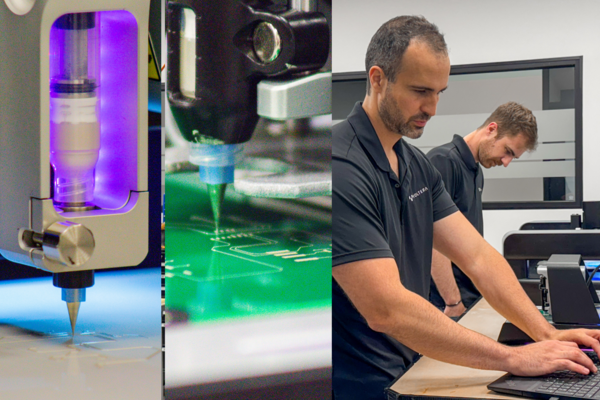
Read more
Voltera prints electronics making prototyping faster and more affordable — accelerating research to market-ready solutions

Read more
Discover how Waterloo alumni are driving Canada’s economy with five tech companies making a local and global impact

Read more
Velocity’s partnership with local hospitals and organizations helps streamline the ideation process for students invested in creating the next big health-tech solution
The University of Waterloo acknowledges that much of our work takes place on the traditional territory of the Neutral, Anishinaabeg, and Haudenosaunee peoples. Our main campus is situated on the Haldimand Tract, the land granted to the Six Nations that includes six miles on each side of the Grand River. Our active work toward reconciliation takes place across our campuses through research, learning, teaching, and community building, and is co-ordinated within the Office of Indigenous Relations.